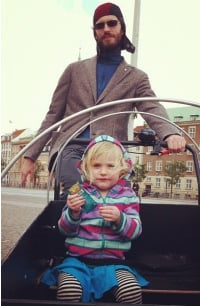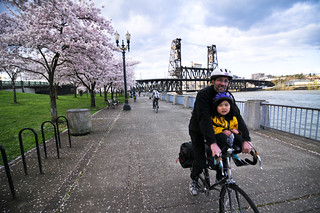
This article was sent in by Chris Anderson, a 33-year-old northeast Portland resident who lives in the Concordia neighborhood. When he’s not riding his e-assist cargo bike with his family he writes mobile phone software for Couchbase.
—
I’m a family biker and a tech entrepreneur who recently returned to Portland. I’ve written this to share my perspective on livable streets, and I’m hoping to meet other people who are interested in the future of Portland. (If this describes you please reach out to me on Twitter @jchris or Facebook.)
A little background: I’m a co-founder of a database technology startup (although at 100 people and healthy revenues, we are starting to outgrow that designation). Reed College brought me to Portland in the late 90’s but I was pulled away for a few years to start the company. Now I’m back, and just joined the Portland Business Alliance, and hope to get active with the City Club and other citizen forums.
“Direct actions of the type that created Waterfront Park and Pioneer Square, as well as smaller neighborhood victories like Two Plum Park, are an integral part of Portland’s history. This is a torch we should all be proud to carry.”
My family knew we couldn’t stay in Mountain View, California (the car culture there is too isolating), so when the company was established enough that I could work remotely, we started thinking about where we wanted to live. Every city is trying to attract successful tech entrepreneurs, and the jobs they bring, so we knew we could live anywhere in the world. With quality of life as the #1 goal, we explored everywhere from Marin County, Austin, and NYC, to Copenhagen, Denmark, before deciding to return to Portland.
The places that appeal to us have a common denominator: human-friendly streetscapes. After having been away from Portland for a few years, upon visiting we were excited to see bicycle boulevards, streetcars on the Eastside, food carts, and more signs that Portland “gets it.” Here is a place we could count on to put humans first in transportation decisions.
Of course as we were planning our return the real texture of Portland politics came into focus. We were dismayed to see the I-5 expansion project being taken seriously, and a silly debate about off-street parking. Cars are not the future, as the younger generation eschews them for more human scale transportation and virtual connectedness. If traffic volumes can only be expected to drop in the long run, why plow billions of dollars into a bigger bridge? A fraction of that money could create livable streets that would make a real difference to Portlanders everyday.
If Portland is going to succeed in the 21st century it needs to maintain it’s leadership in defining the future of American cities. The thoughtful educated talent pool that companies like mine are looking for won’t settle for anything less.
I shared an early draft of this post with a friend and he had this to say:
“Compared to many American cities, if Portland’s further ahead than most in terms of accessibility, bike lanes, etc., then how much is left to do? And how much of that is plausible given the political environment here?”
This increasingly common attitude is exactly what our community needs to challenge. We can’t let statements like this one by Mayor Charlie Hales stand: “transportation choices and bikes and all the other things that we’re doing might have to be deferred a bit while we catch up on maintenance.”
Direct actions of the type that created Waterfront Park and Pioneer Square, as well as smaller neighborhood victories like Two Plum Park, are an integral part of Portland’s history. This is a torch we should all be proud to carry. As the saying goes: ask forgiveness not permission.
A liveable city won’t create itself. What else can we do to remind ourselves that our work is just getting started? In my opinion the best answers are poetic, because poetry is the language of possibility. Fifteen years ago, Critical Mass was the poetry we needed to raise awareness of bikes among drivers. Today we need a new kind of poetry to celebrate the fact that human powered transportation and liveable streets are a common ground for the next generation of Portland’s leaders.
I’ll leave the policy suggestions to the wonks, except for a couple of inspirational what-ifs…
What if we could unlock funding that’s earmarked for traditional, car-centric infrastructure and use it to create first-class liveable streets? Every bike on the road decreases congestion for cars many times over, so funding bike routes is a great way to make driving more efficient.
What if we could subsidize family friendly cargo bikes and trailers the way we subsidize electric and hybrid vehicles? The up-front investment in a cargo bike can be a blocker for someone who isn’t convinced they can give up their car, so ways to soften that will make an outsized impact.
The return to human powered transportation is a marker of today’s generation gap. So radical changes are not only plausible, they are inevitable. It’s just a question of how patient we want to be.
If you have something to say, we’re always looking for new perspectives to share here on the Front Page. Send in your story via our online submission form and we’ll be in touch.


